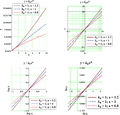Allometry facts for kids
Allometry is the study of the relationship of body size to shape. In particular, it refers to the rate of growth of one part of the body compared to other parts. In most cases, the relative size of body parts changes as the body grows. Most allometric relationships are adaptive. For example, organs which depend on their surface area (such as the intestine) grow faster as the body weight increases.
Also, there are changes in allometry as a clade evolves. Allometry is an important way to describe changes in gross morphology (body shape) during evolution. Changes in time of development in an evolutionary series or clade are very common. The trend is known as heterochrony.
Allometry was first outlined by Otto Snell in 1892, D'Arcy Thompson in 1917, and Julian Huxley in 1932. The relationship between two measured quantities is often expressed as a power law:
 or in a logarithmic form:
or in a logarithmic form: 
where  is the scaling exponent of the law.
is the scaling exponent of the law.
On being the right size
JBS Haldane's 1926 essay On being the right size gives an overview of the way size interacts with body structure. Haldane's thesis is that sheer size very often defines what bodily equipment an animal must have:
- "Insects, being so small, do not have oxygen-carrying bloodstreams. What little oxygen their cells require can be absorbed by simple diffusion of air through their bodies. But being larger means an animal must take on complicated oxygen pumping and distributing systems to reach all the cells".
Many of his examples are based on the square-cube law. If an animal's length is doubled, its surface area will be squared and its weight cubed. This alone causes allometric changes in any evolutionary lineage where successive species get larger of smaller. There are many such lineages.
The bigger an animal gets, the more would they have to change their physical shape, but the weaker they would become.
Images for kids
-
Allometric relations show as straight lines when plotted on double-logarithmic axes
See also
 In Spanish: Alometría para niños
In Spanish: Alometría para niños



